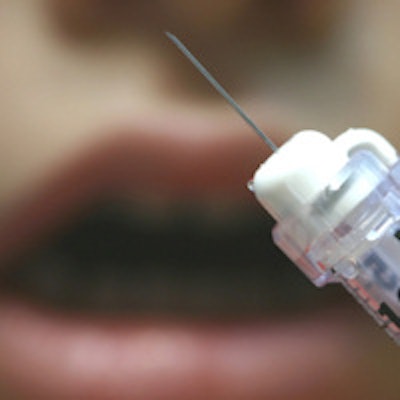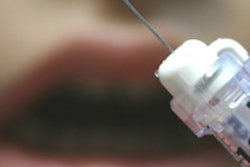
Patient fear of the needle is a regular obstacle for dental professionals. Now St. Renatus, a Colorado start-up, is navigating the U.S. Food and Drug Administration (FDA) approval process to bring an anesthetic in the form of a nasal mist to the market.
The nasal spray, called Kovacaine Mist, is designed to anesthetize the maxillary arch. While the absence of a needle is an important aspect of the technology, it could provide other advantages to a dental practice as well, according to the company.
"A dental assistant can apply this topical drug, allowing for the dentist or dental professional to work more on actual procedures and billable treatments," Jill Shoemaker, vice president of investor relations at St. Renatus, explained in an email to DrBicuspid.com.
In addition, because nasal mist anesthetic does not circulate in the bloodstream for as long as injected anesthetics, it is less harmful to the kidneys, liver, and lungs, according to an article in Innovation News. And since its effect would wear off more quickly, it could mean less drooling after a completed procedure. Also, a pediatric formulation could make treating children with an anesthetic much less stressful for everyone involved.
Inspired by a bloody nose
Founded to commercialize the new needle-free dental anesthetic, St. Renatus entered phase III clinical trials in July of 2012 after it secured up to $3.5 million from an angel investment group in January 2012.
Mark Kollar, DDS, was inspired to create the product after a basketball smashed into his nose during a pickup game of hoops, according to the Innovation News article. He noticed that the nasal spray drug that he received, commonly used by used by ear, nose, and throat physicians when they operate on the nose, numbed his upper teeth as well. The novel drug was successfully patented in 2002; it took only seven years to complete phase I and II safety studies.
“They anticipate being done with all FDA trials by the end of summer 2013.”
After Dr. Kollar partnered with St. Renatus, the company hired Steve Merrick as its first full-time CEO, luring him away from his position as vice president of global marketing for Septodont's pain control division in the fall of 2009.
There is no shortage of optimism that the product, if approved, could be successful -- and a valuable tool for dentists.
"Market research has revealed more than 70% of patients are willing to switch to a dentist that offers the needle-free mist if their current provider doesn't offer the nasal mist anesthetic," Shoemaker said. "Research has also revealed more people who are needle-phobic would visit the dentist."
Positive patient feedback
The results of the company's successful phase II clinical trials were published last month in the Journal of Dental Research (May 20, 2013). Researchers from the department of periodontics and endodontics at the University at Buffalo and other schools compared the effects of Kovacaine Mist (3% tetracaine hydrochloride and 0.05% oxymetazoline hydrochloride) plus a sham infiltration injection to a buffered saline nasal spray plus an active-control intraoral injection (lidocaine hydrochloride 2% and epinephrine injection 1:100,000 in a dental cartridge).
Forty-five adult participants needing restorations participated in the single-center, randomized, double-blind, active-control, parallel-group study. Of the 45 patients, 30 were selected at random to receive the nasal spray, and the remaining 15 received the lidocaine injection.
After the patients received the experimental spray, the researchers monitored vital signs and used a probe to test sensitivity in four sites at regular intervals until one hour after full sensation had returned.
"The occlusal, distal, and mesial surfaces were most often involved for both groups, accounting for 77% of the spray cases and 93% of the lidocaine cases," the researchers noted.
The results were quite positive. During the intent-to-treat analysis, the researchers determined that 83% of nasal spray group required no rescue anesthesia; for one of the five that required it, the rescue anesthetic proved ineffective as well.
"Also, 90% of test individuals had anesthesia success from maxillary premolar to premolar," the researchers noted. The side effects, which included stuffiness, runny nose, numbness of the roof of the mouth, and sneezing, were minor, and the 11 patients who experienced them recovered without assistance.
"The St. Renatus team is very pleased to have the successful phase II data," Shoemaker stated. "They are also very encouraged by the positive patient feedback for the needle-free mist to provide proper anesthesia with significantly less anxiety."
While phase III clinical trials are already underway, some of the testing that is included was revealed in the phase II study. A wide age range of patients will be asked about preferences and facial numbness. In addition, a separate study in children is nearing completion, the researchers noted. "Children have better circulation and a smaller area for delivery of a larger volume of drug, which could be an advantage," they wrote.
So far, phase III appears to be progressing as well as phase II did.
"St. Renatus has seen similar success in the first part of their adult phase III trials," Shoemaker noted. "They anticipate being done with all FDA trials by the end of summer 2013."



















